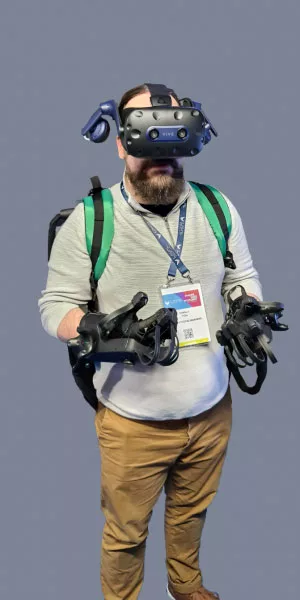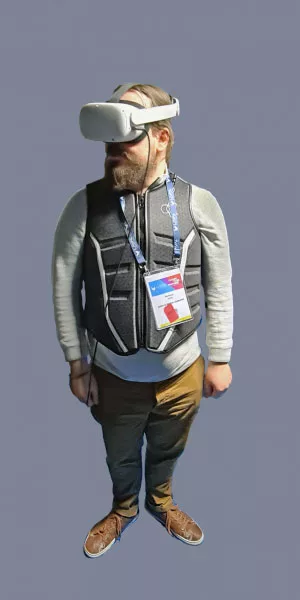The sense of touch in virtual reality: haptic technologies
Reproducing touch: at the interface with the virtual
The HaptX Gloves G1 – HaptX (US) are currently one of the best haptic technologies for touch feedback in VR. The technology, based on a microfluidic approach, is integrated into a glove through numerous actuators about 2 mm in size, which allows for very high spatial precision in tactile feedback for the hands.
For greater immersion, the glove’s exoskeleton also provides a sensation of resistance and dynamic force feedback when grabbing an object in VR. Additionally, it features a magnetic motion capture technology claimed to be sub-millimeter in accuracy.

Tester feedback: It is impressive and promising to be able to experience a sense of touch in immersion. However, the device presented at Laval Virtual seems more like a technological showcase or proof of concept. It appears impractical to deploy routinely for training. The current size and weight of the system make it difficult for individuals to set up on their own: it is nearly impossible to don the gloves without assistance, and the airpack system (a backpack connected to a pneumatic central unit) adds to the complexity of the setup.
The company announces on its website the upcoming release of a more advanced and much lighter version of the device. We look forward to discovering this future version…
Feeling touch in immersion
The Actronika example (France) (€789.95)
The haptic vest, previously tested by the team at Laval Virtual 2022, has moved beyond crowdfunding and is now starting to be distributed. Compatible with both PC and standalone headsets, this vest enables the simulation of “impacts” or touch sensations through its vibrotactile motors positioned at various locations on the vest.
The software tools provided with the vest allow developers to access a library of sensations and even create custom effects felt with the vest (type of effect, location, intensity, etc.).
Feedbacks provided to learners have so far been primarily limited to visual and auditory stimuli, or a few vibrations in VR controllers. A new dimension opens up here, as content creators will now be able to transmit new feedback signals to the user through their torso.
Tester feedback: The sensations provided by this haptic vest are quite impressive. The location of impacts felt with the vest is very accurate compared to what is seen in the simulation. The intensity of the effects is also satisfactory, allowing users to feel both raindrops and explosions or other projectiles.
Use case examples: Awareness of accident risks (electric arc, explosion, collision with a vehicle, etc.), simulation of a hazardous environment (e.g., projections and splashes of dangerous substances).

Smell and hearing: senses that matter in VR
Olfy’s olfactory solution, already tested last year, was once again present to stimulate the sense of smell. This device adds realistic scents to virtual reality. It uses scent diffusers connected to VR software to create an immersive and multisensory experience.
In terms of hearing, sound undeniably plays a key role in immersing educational modules. Unfortunately, this component is often neglected in content. This is partly due to the necessary equipment and the specific skills required. However, the Audace teams have identified the software from Noisemakers. Marketed as a complete studio for creating immersive sound environments, it notably allows for the creation of 3D spatial soundtracks to accurately perceive the source of sounds in the virtual world.

